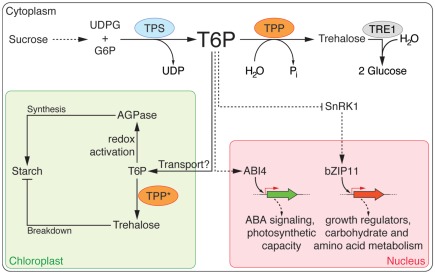Figure 1.
Trehalose biosynthesis and its role in carbohydrate metabolism. Trehalose-6-phosphate (T6P) is synthesized from UDP-glucose (UDPG) and glucose-6-P (G6P) by the activity of trehalose-6-phosphate synthase (TPS) and subsequently converted to trehalose by trehalose-6-phosphate phosphatase (TPP). trehalase1 (TRE1) hydrolyzes trehalose into two molecules of glucose. T6P plays a central role in regulating sugar metabolism in plants. The precursors of T6P are derived from the sucrose metabolism. It has been suggested that T6P is transported by an unknown mechanism into plastids where it induces starch synthesis via thioredoxin-mediated activation of AGPase. T6P might be converted into trehalose, which has been shown to regulate starch breakdown in plastids. Several TPPs (marked with an asterisk) have been predicted to localize to plastids, but this still needs to be confirmed experimentally. SnRK1, which represses plant growth, is inhibited by T6P. A regulatory loop, which involves T6P, SnRK1, and bZIP11, and that is thought to control sucrose availability and utilization, has been proposed.

